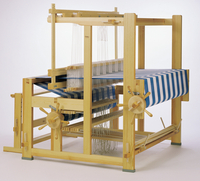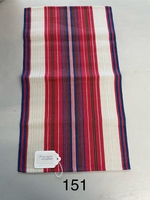Glossary
The navigation buttons on the left will help you with lots of other terms and definitions.
Loom and Equipment Terms
Drafting Terms
Balanced Weave- A Weave which has the same number of weft threads per inch as warp Threads
Dents- Narrow space in the reed where the threads pass, stated by the number of dents per inch or dents per 10cm
Draft- A diagram representing the threading, tie-up, and treadling for a weave
Ends- Individual warp threads of a prepared warp
EPI- Ends Per Inch, or the number of warp threads per inch
Plain Weave- The most basic of weaves, made by weaving one warp thread over and one warp thread under
Ply- The number of threads twisted together to make one thread
PPI- Picks per inch, the number of weft threads per inch
Selvage- The frim woven edge of the fabric where the weft turns
Sett- The number of warp threads per inch
Shot(Pick)- A single pass of weft through the shed
Tabby- Plain Weave, made by weaving one warp thread over and one warp thread under
Take-Up- The Amount that the warp shortens in length due to the undulation caused by the weaving
Threading Draft- Instructions for threading the heddles
Tie-Up Draft- Instructions for tying up the treadles on a loom, indicating which shafts rise and which sink
Treadling Draft- Instructions for treadling a weave, giving the order for using the treadles for weaving
Warp- Threads running from the warp beam to the cloth beam, across which threads are woven
Weft- Threads which are woven crosswise to the warp to form the web
Loom Parts and Equipment Terms
Back Beam- Removeable beam between the shafts ad the warp beam, over which the warp passes
Breast Beam- Removeable beam at the front of the loom over which the cloth passes before it passes over the knee beam and onto the cloth beam
Cloth Beam- Rotating beam at the front of the loom which holds the woven cloth
Beam Cord- Cords used to attach the tie-on bar to the beam
Knee Beam- Removeable beam above the cloth beam over which the cloth passes before it winds onto the cloth beam. It keeps the cloth above the weaver's knee
Warp Beam- Removeable rotating beam at the back of the loom which holds the warp
Beaming Sticks- The thin sticks placed on the warp beam threads while beaming
Beater- Swinging frame holding the removable reed, used to beat the weft in place
Beater Cradles- Two separate, adjustable pieces of wood with several settings which hold the beater
Hanging Beater- A beater which is hanging from the top of the castle
Lower or Underslung Beater- A beater which is attached to the bottom of the loom
Bobbin- A flanged spool for a boat shuttle on which weft thread is wound
Bobbin Winder- A tool for winding bobbins or quills either by hand or electric power. Thin spindle winders wind paper and cardboard quills as well as bobbins.
Brake- A device to hold a warp beam from turning
Castles(gables)- Tall side frames of a loom holding the cross beams
Counterbalance Tie-Up- A loom tie up system with pulleys and/or horses or rotating dowels to attach the shafts. When a shed is made some shafts rise and some sink.
Countermarch Tie-Up- A loom with jacks at the top and two sets of lamms. When a shed is made some shafts rise and some sink
Drawloom- A two harness loom, the first harness consisting of 4-8 ground weave shafts and the second harness of many shafts creating pattern sheds
Drall Pulleys- A package of counterbalance pulleys used for ying up weaves which have up to 10 shafts
Fabric Protection Board- A thin board attached to the breast beam to protect the woven fabric
Harness(see shaft)- A set of two or more shafts which hold the heddles
Horizontal Countermarch- A countermarch which has a set of horizontally placed jacks on each side of the loom placed the top of the loom
Horses- Short bars of wood between the shafts and the pulleys at the top of the loom in the counterbalance tie-up of more than two shafts
Jacks- Levers used to raise shafts on jack and countermarch looms. Jack is an old English term for horse.
Jack Loom- A loom with jacks below the shafts to push the shafts up or on top of the loom to pull the shafts up. When a shed is made some shafts rise.
Lamms- Horizontal wooden bars which attach the treadles to the shafts
Pawl- A stopper attached to the loom frame which falls into a ratchet tooth to keep the ratchet from rotating
Pick-Up Stick- A thin stick for picking up warp threads to make sheds for weaving
Quill- A thin paper or cardboard tube on which weft threads are wound for use in a boat shuttle
Ratchet- A toothed wheel placed at the end of cloth and warp beams which is held by a pawl to keep the beam from rotating
Shaft- A frame or two bars with heddles which raise or lower warp threads
Shaft Bars(Heddle Bars)- The two bars which hold the heddles to make a shaft
Boat Shuttle- A boat shaped shuttle which is hollowed out to hold a bobbin or quill of weft thread
Ski Shuttle- A shuttle with upturned ends which is used for rug weaving
Stick Shuttle- A smooth flat stick to hold weft for weaving
Shuttle Race- A horizontal shelf in front of the reed attached to the beater on jack looms and looms with fly shuttles
Umbrella Swift- A rotating skein holder for unwinding skeins
Temple(Stretcher)- Adjustable wooden or metal bar with sharp points to maintain weaving width
Texsolv- The name for heddles and tie-up cord made of polyester which eliminates the need to tie knots
Treadles- Foot pedals used to move the shafts
Vertical Countermarch- A countermarch loom which has one jack for each shaft held vertically on top of the loom
Warping and Tie-Up Terms
Anchor Pins- Plastic pins with two legs are used to attach Texsolv cord to the wooden loom parts
Arrow Pegs- Arrow Shaped, straight, plastic pegs to act as a stopper in Texsolv cord
Back to Front- A phrase used to describe the traditional warping method
Bout- One wound group of warp threads, tied together, which contains part of the warp width
Beaming(Winding On)- Winding the warp onto the warp beam, after it is spread out to it's weaving width
Beaming Sticks- The thin sticks placed on the warp beam threads while beaming
Cord Threader- A pointed wire loop attached to a handle used for threading cords through holes
Direct Tie-Up- Tying only one treadle cord to each treadle
Eye- A small hole in a heddle through which a thread is passes
Front to Back- A non-traditional warping method where heddles are threaded before the warp is beamed
Guide String- A cord measured to be the same length as the warp and used as a guide for winding the warp bouts
Heddle- A wire, metal, string, or Texsolv polyester loop held by the shaft bards, containing a threading eye.
Lease Cross- The crossing of warp threads. made while winding the warp, to keep the threads in order for warping
Lease Sticks- Flat, thin, smooth, wooden sticks put into the lease cross to keep the order of threads
Locking Pins- Metal rods which are used to stabilize a countermarch assembly
Overhand Knot- A common useful knot, which does not slip
Pawl- A strong metal stopper which catches the teeth of a ratchet wheel to hold the warp tension
Pre-Sleying a Reed- Spacing the warp ends through a reed, so that the warp threads
Raddle- A long narrow piece of wood with metal hoops or metal pins every 1/4" or 1/2", used to spread the warp evenly for beam the warp onto the warp beam. Commonly used before reeds were made of metal.
Reed- A comb like part of a loom which firs into the beater. It spaces the warp threads evenly
Reed Holders- A pair of wooden holders which hold a reed upright and at an angle for pre-sleying the reed
Retaining Cord- A cord ted to the ends of shaft bars to hold the heddles and on the tie-on bars
Sectional Beam- A warp beam with four boards with inserted pins, dowels or metal hoops every inch or two inches
Sectional Warping- A method of for winding a warp used for long warps. The warp is wound onto spools, one for each end in a section of one or two inches. These warps are wound into each section through a tension box. A lease is made in the warp, the warp is cut and secured before the next section is wound.
Selvage Papers- A single layer of paper with a thicker folded edge for maintaining even warp tension, inserted under a few selvage threads so that the folded edge will support the beaming sticks
Sett- The number of warp threads per inch
Shaft Holders- Wooden bars with notches to hold the shafts while threading the heddles
Shaft Pins- Wire "safety" pins used on the ends of shafts to stabilize them
Shed- The space between rising and sinking warp threads where the shuttle weaves the weft
Sley Hook (Reed Hook)- A thin flat hook for pulling the threads where the shuttle weaves the weft
Sleying- Passing the warp ends through the dents in the reed
Take-Up- The shortening of the warp in length during weaving
Texsolv Cord- Polyester cord with with openings every 1/2 inch, used with plastic pins, eliminating the need to tie knots when tying up a loom
Threading- Drawing the warp threads through the eyes of the heddles
Threading Hook- A tool with a long, fine, thin hook used to pull the warp ends through the heddle eyes
Thrums- Also called loom waste, the unwoven warp left when the last woven piece is cut from the loom
Tie-Up- The tying or connecting of cords to hand the shafts, lamms, and/or treadles
Tie-On Bar- The bar, usually wooden, attached to the warp and cloth beams with beam cords. Warp threads are attached to the tie-on bars during warping
Warp- The threads prepared to be put on a loom as well as putting them on the loom
Warping- Making a warp and putting it onto the loom
Warping Frame- A frame with wooden pegs for measuring warp threads
Warping Reel(Mill)- Large revolving cylindrical frame for winding short or long warps
Weft(filling, woof)- Threads which are woven crosswise to the warp to form the web



